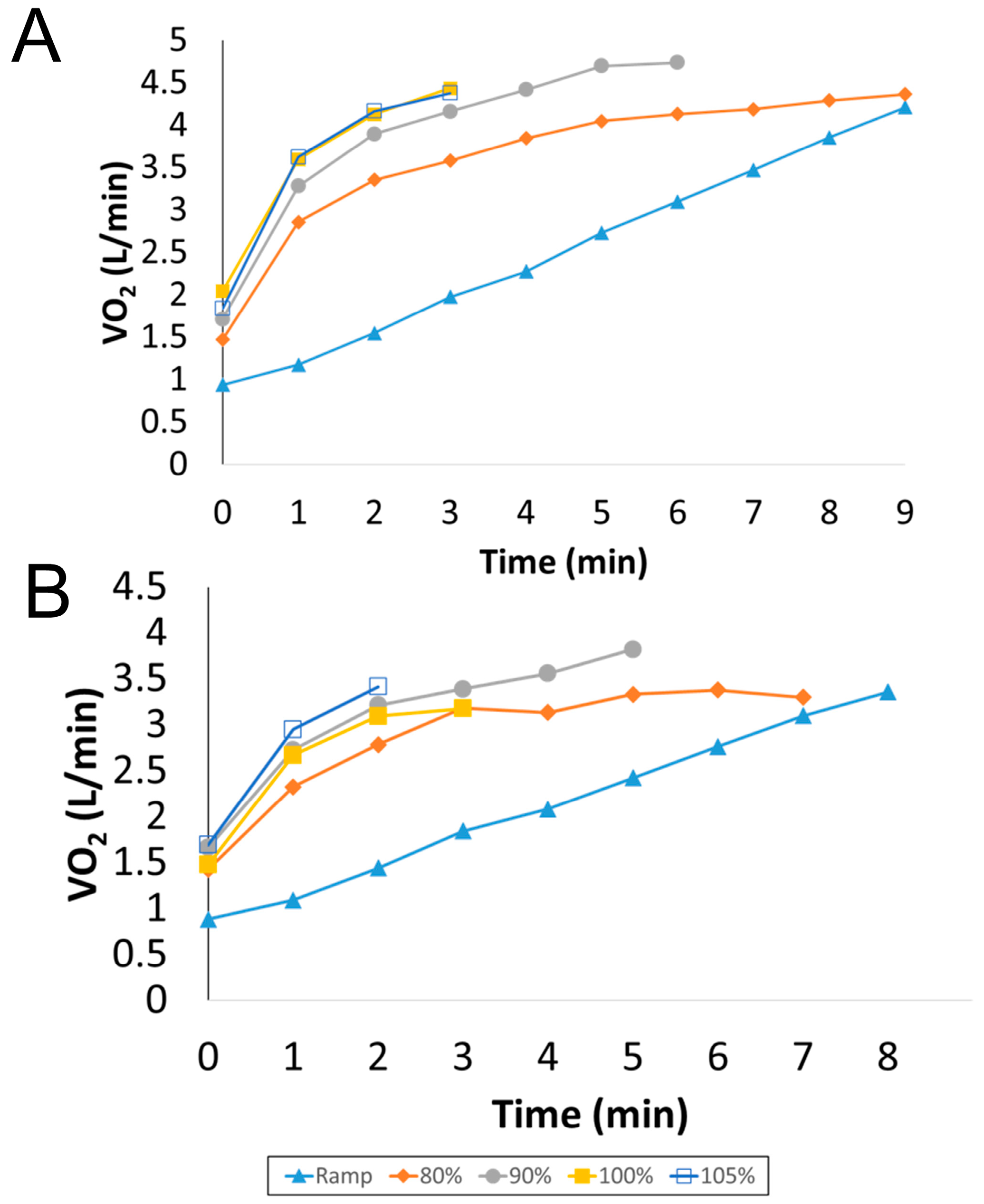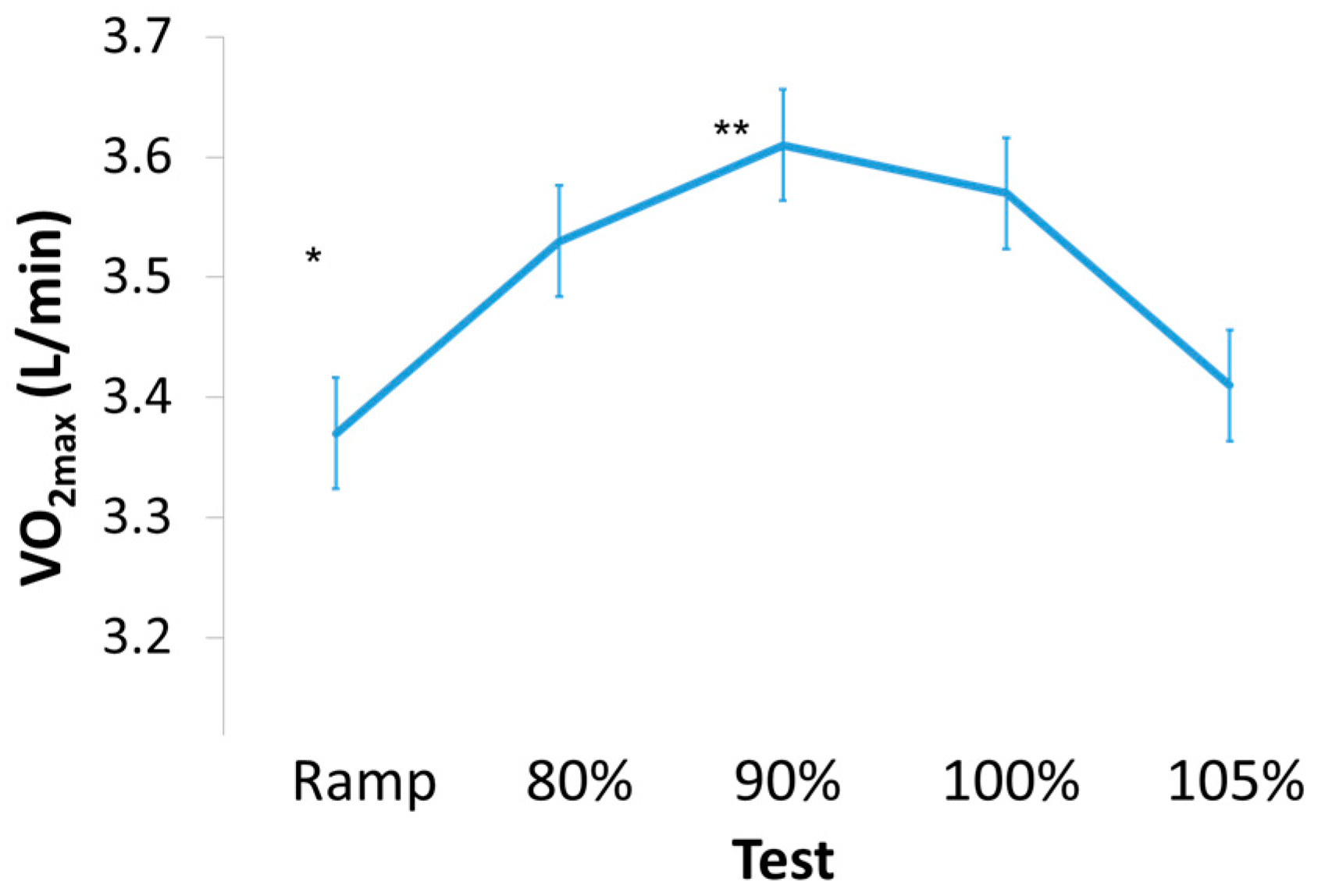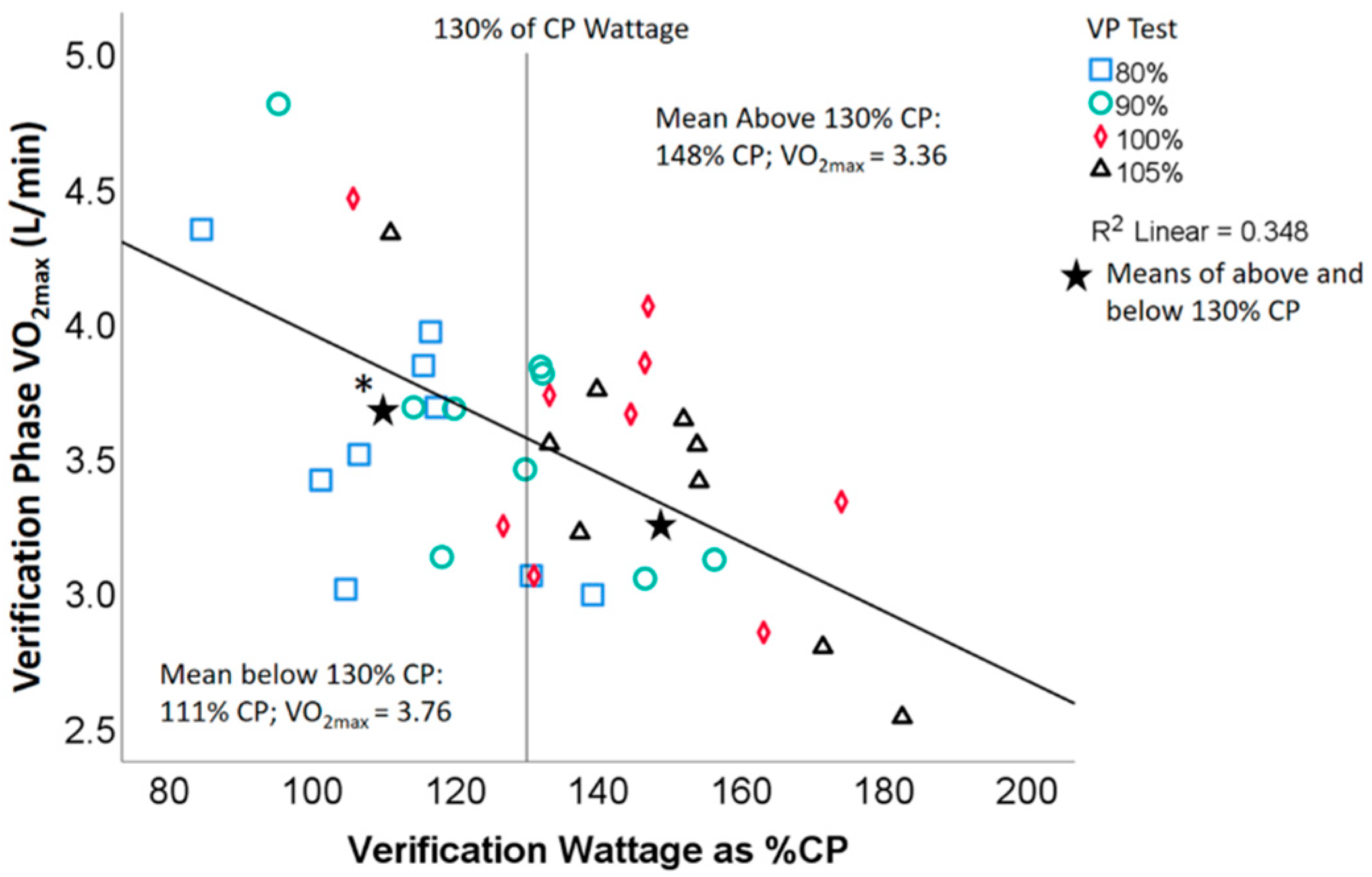Determining the Optimal Workrate for Cycle Ergometer Verification Phase Testing in Males with Obesity
Abstract
:1. Introduction
2. Materials and Methods
2.1. Subjects
2.2. Experimental Design
2.3. Statistical Analysis
3. Results
4. Discussion
Strengths and Limitations
5. Conclusions
Author Contributions
Funding
Institutional Review Board Statement
Informed Consent Statement
Data Availability Statement
Acknowledgments
Conflicts of Interest
References
- Shepherd, R.J.; Allen, C.; Benade, A.J.S.; Davies, C.T.; Di Prampero, P.E.; Hedman, R.; Merriman, J.E.; Myhre, K.; Simmons, R. The maximum oxygen intake. An international reference standard of cardiorespiratory fitness. Bull. WHO 1968, 38, 757–764. [Google Scholar]
- Midgley, A.W.; Carroll, S. Emergence of the verification phase procedure for confirming ‘true’ VO2max. Scand. J. Med. Sci. Sports 2009, 19, 313–322. [Google Scholar] [CrossRef] [PubMed] [Green Version]
- Day, J.R.; Rossiter, H.B.; Coats, E.M.; Skasick, A.; Whipp, B.J. The maximally attainable VO2 during exercise in humans: The peak vs. maximum issue. J. Appl. Physiol. 2003, 95, 1901–1907. [Google Scholar] [CrossRef] [PubMed] [Green Version]
- Poole, D.C.; Wilkerson, D.P.; Jones, A.M. Validity of criteria for establishing maximal O2 uptake during ramp exercise tests. Graefe’s Arch. Clin. Exp. Ophthalmol. 2008, 102, 403–410. [Google Scholar] [CrossRef] [PubMed]
- Midgley, A.W.; Carroll, S.; Marchant, D.; McNaughton, L.R.; Siegler, J. Evaluation of true maximal oxygen uptake based on a novel set of standardized criteria. Appl. Physiol. Nutr. Metab. 2009, 34, 115–123. [Google Scholar] [CrossRef] [PubMed] [Green Version]
- Astorino, T.A.; White, A.C.; Dalleck, L.C. Supramaximal Testing to Confirm Attainment of VO2max in Sedentary Men and Women. Int. J. Sports Med. 2009, 30, 279–284. [Google Scholar] [CrossRef]
- Mitchell, J.H.; Sproule, B.J.; Chapman, C.B. The Physiological Meaning of the Maximal Oxygen Intake Test. J. Clin. Investig. 1958, 37, 538–547. [Google Scholar] [CrossRef] [PubMed] [Green Version]
- Astorino, T.A.; Willey, J.; Kinnahan, J.; Larsson, S.M.; Welch, H.; Dalleck, L.C. Elucidating determinants of the plateau in oxygen consumption at VO2max. Br. J. Sports Med. 2005, 39, 655–660. [Google Scholar] [CrossRef] [PubMed] [Green Version]
- Buchfuhrer, M.J.; Hansen, J.E.; Robinson, T.E.; Sue, D.Y.; Wasserman, K.; Whipp, B.J. Optimizing the exercise protocol for cardiopulmonary assessment. J. Appl. Physiol. 1983, 55, 1558–1564. [Google Scholar] [CrossRef] [PubMed]
- Sawyer, B.J.; Tucker, W.J.; Bhammar, D.M.; Gaesser, G.A. Using a verification test for determination of VO2max in sedentary adults with obesity. J. Strength Cond. Res. 2015, 29, 3432–3438. [Google Scholar] [CrossRef]
- Jones, A.M.; Vanhatalo, A.; Burnley, M.; Morton, R.H.; Poole, D.C. Critical Power: Implications for Determination of VO2max and Exercise Tolerance. Med. Sci. Sports Exerc. 2010, 42, 1876–1890. [Google Scholar] [CrossRef] [PubMed]
- Midgley, A.W.; McNaughton, L.R.; Carroll, S. Verification phase as a useful tool in the determination of the maximal oxygen uptake of distance runners. Appl. Physiol. Nutr. Metab. 2006, 31, 541–548. [Google Scholar] [CrossRef] [PubMed]
- Mier, C.M.; Alexander, R.P.; Mageean, A.L. Achievement of VO2max criteria during a continuous graded exercise test and a verification stage performed by college athletes. J. Strength Cond. Res. 2012, 26, 2648–2654. [Google Scholar] [CrossRef] [PubMed]
- Snell, P.G.; Stray-Gundersen, J.; Levine, B.D.; Hawkins, M.N.; Raven, P.B. Maximal Oxygen Uptake as a Parametric Measure of Cardiorespiratory Capacity. Med. Sci. Sports Exerc. 2007, 39, 103–107. [Google Scholar] [CrossRef] [PubMed]
- Astorino, T.A.; White, A.C. Assessment of anaerobic power to verify VO2max attainment. Clin. Physiol. Funct. Imaging 2010, 30, 294–300. [Google Scholar] [CrossRef] [PubMed]
- Sanchez-Otero, T.; Iglesias-Soler, E.; Boullosa, D.; Tuimil, J.L. Verification criteria for the determination of Vo2 MAX in the field. J. Strength Cond. Res. 2014, 28, 3544–3551. [Google Scholar] [CrossRef] [PubMed]
- Rossiter, H.B.; Kowalchuk, J.M.; Whipp, B.J. A test to establish maximum O2 uptake despite no plateau in the O2 uptake re-sponse to ramp incremental exercise. J. Appl. Physiol. 2006, 100, 764–770. [Google Scholar] [CrossRef]
- Hill, D.W.; Poole, D.C.; Smith, J.C. The relationship between power and the time to achieve VO2max. Med. Sci. Sport Exerc. 2002, 34, 709–714. [Google Scholar] [CrossRef]
- Foster, C.; Kuffel, E.; Bradley, N.; Battista, R.A.; Wright, G.; Porcari, J.P.; Lucia, A.; De Koning, J.J. VO2max during successive maximal efforts. Graefe’s Arch. Clin. Exp. Ophthalmol. 2007, 102, 67–72. [Google Scholar] [CrossRef]
- Morgan, D.W.; Baldini, F.D.; Martin, P.E.; Kohrt, W.M. Ten kilometer performance and predicted velocity at VO2max among well-trained male runners. Med. Sci. Sports Exerc. 1989, 21, 78–83. [Google Scholar] [CrossRef]
- Sedgeman, D.; Dalleck, L.; Clark, I.E.; Jamnick, N.; Pettitt, R.W. Analysis of Square-wave Bouts to Verify VO2max. Int. J. Sports Med. 2013, 34, 1058–1062. [Google Scholar] [CrossRef] [PubMed]
- Dalleck, L.C.; Astorino, T.A.; Erickson, R.M.; McCarthy, C.M.; Beadell, A.A.; Botten, B.H. Suitability of verification testing to confirm attainment of VO₂max in middle-aged and older adults. Res. Sports Med. 2012, 20, 118–128. [Google Scholar] [CrossRef]
- Scharhag-Rosenberger, F.; Carlsohn, A.; Cassel, M.; Mayer, F.; Scharhag, J. How to test maximal oxygen uptake: A study on timing and testing procedure of a supramaximal verification test. Appl. Physiol. Nutr. Metab. 2011, 36, 153–160. [Google Scholar] [CrossRef]
- Astorino, T.A.; De La Rosa, A.B.; Clark, A.; De Revere, J.L. Verification Testing to Confirm VO2max Attainment in Inactive Women with Obesity. Int. J. Exerc. Sci 2020, 13, 1448–1458. [Google Scholar] [PubMed]
- Moreno-Cabañas, A.; Ortega, J.F.; Morales-Palomo, F.; Ramirez-Jimenez, M.; Mora-Rodriguez, R. Importance of a verification test to accurately assess VO 2 max in unfit individuals with obesity. Scand. J. Med. Sci. Sports 2019, 30, 583–590. [Google Scholar] [CrossRef] [Green Version]
- Kirkeberg, J.M.; Dalleck, L.C.; Kamphoff, C.S.; Pettitt, R.W. Validity of 3 Protocols for Verifying VO2max. Int. J. Sports Med. 2011, 32, 266–270. [Google Scholar] [CrossRef] [PubMed]
- Sawyer, B.J.; McMahon, N.; Thornhill, K.L.; Baughman, B.R.; Mahoney, J.M.; Pattison, K.L.; Freeberg, K.A.; Botts, R.T. Supra-versus submaxiaml cycle ergometer verificaiton of VO2max in males and females. Sports 2020, 8, 163. [Google Scholar] [CrossRef]
- Wood, R.E.; Hill, A.P.; Hunter, G.R.; King, N.A.; Byrne, N.M. VO2max in overweight and obese adults: Do they meet the threshold criteria? Med. Sci. Sport Exerc. 2010, 42, 470–477. [Google Scholar] [CrossRef] [PubMed]
- Myers, J.; Bellin, D. Ramp Exercise Protocols for Clinical and Cardiopulmonary Exercise Testing. Sports Med. 2000, 30, 23–29. [Google Scholar] [CrossRef] [PubMed]
- Burnley, M.; Doust, J.H.; Vanhatalo, A. A 3-min All-Out Test to Determine Peak Oxygen Uptake and the Maximal Steady State. Med. Sci. Sports Exerc. 2006, 38, 1995–2003. [Google Scholar] [CrossRef] [PubMed]
- Riebe, D.; Franklin, B.A.; Thompson, P.D.; Garber, C.E.; Whitfield, G.P.; Magal, M.; Pescatello, L.S. Updating ACSM’s Recommendations for Exercise Preparticipation Health Screening. Med. Sci. Sports Exerc. 2015, 47, 2473–2479. [Google Scholar] [CrossRef] [Green Version]
- Faul, F.; Erdfelder, E.; Lang, A.-G.; Buchner, A. G* Power 3: A flexible statistical power analysis program for the social, be-havioral and biomedical sciences. Behav. Res. Methods. 2007, 39, 175–191. [Google Scholar] [CrossRef]
- Adams, R. Revised Physical Activity Readiness Questionnaire. Can. Fam. Physician Med. de Fam. Can. 1999, 45, 992–1005. [Google Scholar]
- Jackson, A.S.; Blair, S.N.; Mahar, M.T.; Wier, L.T.; Ross, R.M.; Stuteville, J.E. Prediction of functional aerobic capacity without exercise testing. Med. Sci. Sports Exerc. 1990, 22, 863–870. [Google Scholar] [CrossRef] [PubMed]
- ACSM. ACSM’s Guidelines for Exercise Testing and Prescription, 7th ed.; Wolters Kluwer Health/Lippincott Williams and Wilkins: Philidelphia, PA, USA, 2014. [Google Scholar]
- Dicks, N.D.; Jamnick, N.A.; Murray, S.R.; Pettitt, R.W. Load Determination for the 3-Minute All-Out Exercise Test for Cycle Ergometry. Int. J. Sports Physiol. Perform. 2016, 11, 197–203. [Google Scholar] [CrossRef]
- Yoon, B.-K.; Kravitz, L.; Robergs, R. VO2max, Protocol Duration, and the VO2 Plateau. Med. Sci. Sports Exerc. 2007, 39, 1186–1192. [Google Scholar] [CrossRef] [PubMed]
- Carter, H.; Pringle, J.S.M.; Jones, A.M.; Doust, J.H. Oxygen uptake kinetics during treadmill running across exercise intensity domains. Graefe’s Arch. Clin. Exp. Ophthalmol. 2002, 86, 347–354. [Google Scholar] [CrossRef] [PubMed]
- Poole, D.C.; Ward, S.A.; Gardner, G.W.; Whipp, B.J. Metabolic and respiratory profile of the upper limit for prolonged exercise in man. Ergonomics 1988, 31, 1265–1279. [Google Scholar] [CrossRef]
- Hill, D.W. The Critical Power Concept. Sports Med. 1993, 16, 237–254. [Google Scholar] [CrossRef] [PubMed]
- Hill, D.W.; Ferguson, C.S. A physiological description of critical velocity. Graefe’s Arch. Clin. Exp. Ophthalmol. 1999, 79, 290–293. [Google Scholar] [CrossRef] [PubMed]
- Poole, D.C.; Ward, S.A.; Whipp, B.J. The effects of training on the metabolic and respiratory profile of high-intensity cycle ergometer exercise. Graefe’s Arch. Clin. Exp. Ophthalmol. 1990, 59, 421–429. [Google Scholar] [CrossRef] [PubMed]
- Sawyer, B.; Morton, R.H.; Womack, C.J.; Gaesser, G.A. VO2max May Not Be Reached during Exercise to Exhaustion above Critical Power. Med. Sci. Sports Exerc. 2012, 44, 1533–1538. [Google Scholar] [CrossRef] [PubMed]
- Astorino, T.A.; Robergs, R.A.; Ghiasvand, F.; Marks, D.; Burns, S. Incidence of the oxygen plateau during VO2max exercise testing to volitional fatigue. J. Exerc. Physiol. 2000, 3, 1–12. [Google Scholar]
- Wells, J.C.K.; Fewtrell, M.S. Measuring body composition. Arch. Dis. Child. 2006, 91, 612–617. [Google Scholar] [CrossRef] [PubMed] [Green Version]



| Variable | Number | Minimum | Maximum | Mean | Standard Deviation |
|---|---|---|---|---|---|
| Age (yr) | 9 | 18 | 34 | 24 | 6 |
| Height (cm) | 9 | 170.2 | 190.5 | 180.1 | 6.5 |
| Weight (kg) | 9 | 93.2 | 149.5 | 103.0 | 17.4 |
| BMI (kg m−2) | 9 | 30.27 | 43.40 | 33.19 | 4.19 |
| VO2max (ml/kg/min) | 9 | 23.50 | 46.10 | 35.13 | 6.68 |
| Critical Power (W) | 9 | 141 | 325 | 205 | 54 |
| Test | VO2 (L/min) | HRmax (bpm) | RER | BL (mM) | Peak Wattage | Time (s) | RPE | % of CP Wattage |
|---|---|---|---|---|---|---|---|---|
| Ramp | 3.37 ± 0.39 | 175.4 ± 12.5 | 1.26 ± 0.08 | 12.3 ± 2.4 | 281 ± 35 | 497 ± 24 | 17 ± 4 | – |
| 80% | 3.53 ± 0.47 | 177.1 ± 15.8 | 1.25 ± 0.06 | 13.8 ± 2.7 | 224 ± 28 | 418 ± 153 | 19 ± 1 | 113 ± 16 |
| 90% | 3.61 ± 0.54 | 176.2 ± 14.0 | 1.25 ± 0.08 | 13.6 ± 3.1 | 253 ± 32 | 282 ± 56 | 17 ± 3 | 127 ± 18 |
| 100% | 3.57 ± 0.51 | 176.0 ± 13.1 | 1.32 ± 0.10 | 12.7 ± 2.4 | 281 ± 35 | 203 ± 27 | 17 ± 2 | 141 ± 20 |
| 105% | 3.41 ± 0.53 | 169.8 ± 17.1 | 1.32 ± 0.05 | 12.3 ± 2.1 | 295 ± 37 | 167 ± 40 | 17 ± 3 | 148 ± 21 |
Publisher’s Note: MDPI stays neutral with regard to jurisdictional claims in published maps and institutional affiliations. |
© 2021 by the authors. Licensee MDPI, Basel, Switzerland. This article is an open access article distributed under the terms and conditions of the Creative Commons Attribution (CC BY) license (http://creativecommons.org/licenses/by/4.0/).
Share and Cite
Mahoney, J.M.; Baughman, B.R.; Sheard, A.C.; Sawyer, B.J. Determining the Optimal Workrate for Cycle Ergometer Verification Phase Testing in Males with Obesity. Sports 2021, 9, 30. https://doi.org/10.3390/sports9020030
Mahoney JM, Baughman BR, Sheard AC, Sawyer BJ. Determining the Optimal Workrate for Cycle Ergometer Verification Phase Testing in Males with Obesity. Sports. 2021; 9(2):30. https://doi.org/10.3390/sports9020030
Chicago/Turabian StyleMahoney, Jenny M., Brett R. Baughman, Ailish C. Sheard, and Brandon J. Sawyer. 2021. "Determining the Optimal Workrate for Cycle Ergometer Verification Phase Testing in Males with Obesity" Sports 9, no. 2: 30. https://doi.org/10.3390/sports9020030






